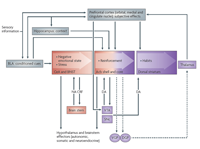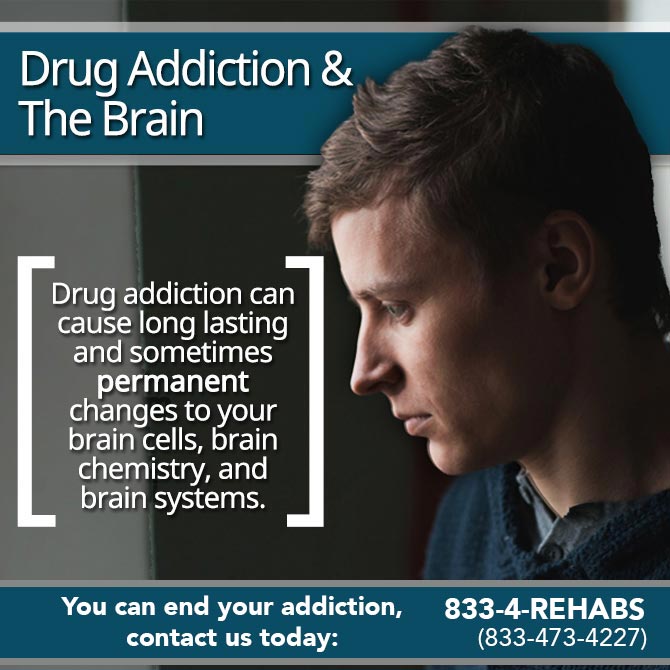Drug Addiction Is A Serious Medical Problem That Can Be Overcome

Scientists and physicians have known for quite some time that drug addiction causes serious damage to the brain . Decades of research have shown that drug addiction causes long-lasting and sometimes permanent changes to brain cells, brain chemistry, and brain systems. Furthermore, studies have demonstrated that different types and locations of brain changes occur during different parts of the addiction cycle. Molecular changes have also been documented but will not be described here. An important goal in substance abuse research and treatment has been to use this information to develop behavioral and medical treatments that can reverse or offset these brain changes. It is important to note that both behavioral and drug therapies have the potential to change the brain in ways that can support recovery.
There are three stages to addiction, each with its own underlying neurobiology
Leaders in the field have suggested that there are three stages to addiction, each with its own underlying neurobiology. The first stage, called “binge-intoxication”, is characterized by positive reinforcement from drugs; that is, taking a drug is rewarding (eg, it may make one feel good, enhance performance, reduce pain or anxiety, etc.), and that leads people to do it again. During this stage, drug use is considered to be impulsive, rather than compulsive. The second stage is referred to as “withdrawal-negative affect.” In this stage, the motivation for drug use begins to shift away from the positive effects of the drug toward avoiding the negative effects of drug withdrawal. This is part of the transition from impulsive to compulsive behavior. The third and final stage has been termed “preoccupation-anticipation” and involves drug craving and compulsive drug seeking behavior.
Three main circuits in the brain that underlie these three stages of addiction
 Although an oversimplification, three main circuits in the brain have been recognized to underlie these three stages of addiction. A circuit refers to a pathway of nerves that connect different structures in the brain. Within the circuit, each structure plays a role, and each one affects the next one in line via the release of chemical messengers. These brain circuits may become active prior to, during, or after a drug use. And although the circuits are described in basic terms below, it is important to note that the brain is a highly complex organ with numerous interconnections and sophisticated chemical regulation.
Although an oversimplification, three main circuits in the brain have been recognized to underlie these three stages of addiction. A circuit refers to a pathway of nerves that connect different structures in the brain. Within the circuit, each structure plays a role, and each one affects the next one in line via the release of chemical messengers. These brain circuits may become active prior to, during, or after a drug use. And although the circuits are described in basic terms below, it is important to note that the brain is a highly complex organ with numerous interconnections and sophisticated chemical regulation.
Binge-intoxication
In the “binge-intoxication” stage, a part of the brain called the mesolimbic dopamine system is primary. “Mesolimbic” refers to the specific part of the brain, and “dopamine” is an important (but not the only) chemical messenger involved. The limbic system of the brain is involved in a number of functions, including emotions and motivated behaviors. The mesolimbic dopamine system specifically is associated with the rewarding effects of drugs (as well as other rewarding stimuli).
Withdrawal-negative affect
During the “withdrawal-negative affect” stage, the mesolimbic reward circuit may be disrupted (eg, decreased dopamine activity). During this stage, it may be more difficult for individuals to experience the positive rewarding effects of the drug, and use is motivated primarily by the desire to avoid withdrawal symptoms. Brain pathways associated with stress responses are also stimulated during this time.
Preoccupation-anticipation
A different circuit in the brain is thought to be involved in drug craving and its effects on drug taking (“preoccupation-anticipation”). This circuit involves the prefrontal cortex of the brain and its connections to two other structures, the amygdala and the nucleus accumbens. In this circuit the key chemical messenger (but again, not the only one) is called glutamate. Among other things, the prefrontal cortex is associated with high-level cognitive behavior, including decision-making and emotional regulation. The amygdala participates in the formation and storage of memories, particularly emotional memories. Finally, the nucleus accumbens is a part of the brain involved in reward, pleasure, addiction, and aggression, in addition to other behaviors.
The need for continued development of new and better addiction treatment approaches
Although much remains unknown, our current understanding of the neurobiology of addiction underscores the complexity of the problem. Numerous brain structures and circuits are affected by drug use and addiction, and some effects can be long-lasting and difficult to reverse. The wide distribution and varied functions of the brain regions involved in addiction help to explain the chronic and tenacious nature of substance abuse and emphasizes the need for continued development of new and better treatment approaches.



